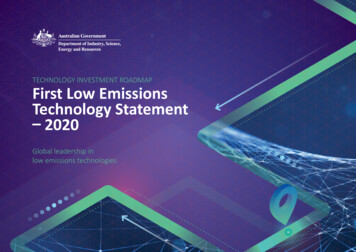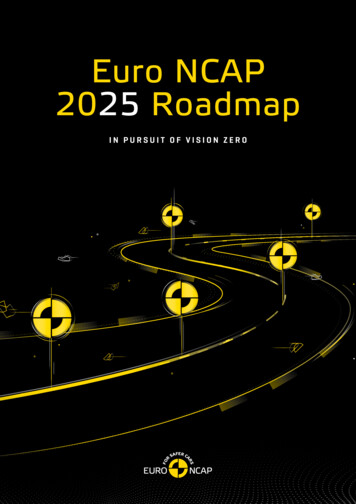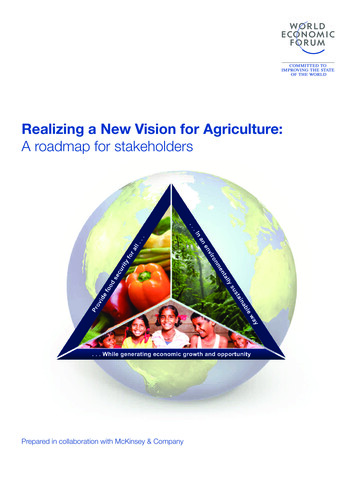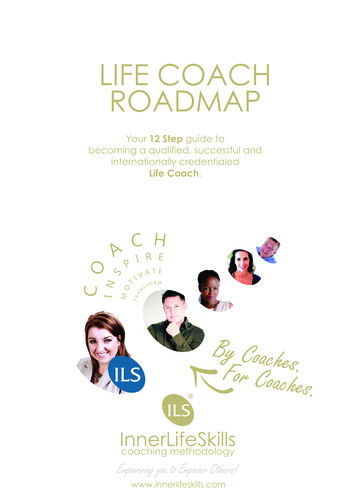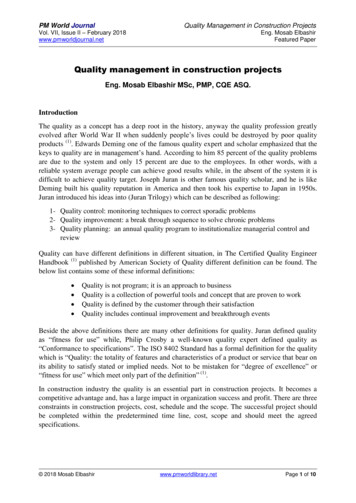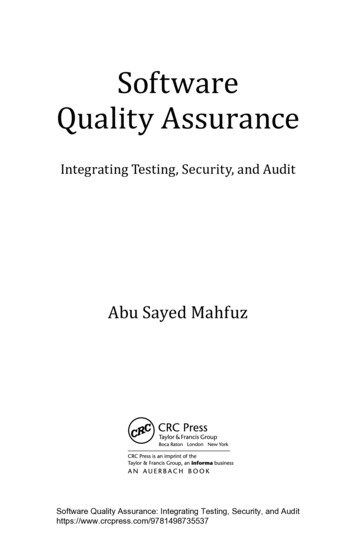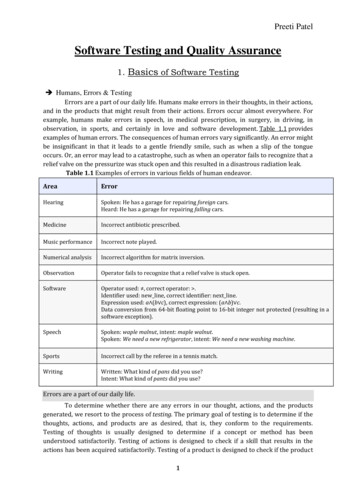
Transcription
Printed in AustriaV.06-59455—February 2007—200An e-learning Manual for Implementing Total Quality ManagementVolume 1A Roadmap to Quality—Volume 1UNITED NATIONS INDUSTRIAL DEVELOPMENT ORGANIZATIONTrade Capacity-building BranchVienna International Centre, P.O. Box 300, 1400 Vienna, AustriaTelephone: ( 43-1) 26026-0, Fax: ( 43-1) 26926-69E-mail: unido@unido.org, Internet: http://www.unido.orgUNITED NATIONSINDUSTRIAL DEVELOPMENT ORGANIZATION
A Roadmap to QualityAn e-learning Manual for ImplementingTotal Quality ManagementVolume 1UNITED NATIONS INDUSTRIAL DEVELOPMENT ORGANIZATIONVienna, 2007
This publication has not been formally edited.
ewTrainer guidelinesIntroduction to TQMOriginsNeeds analysisGlossaryModule One: Leadership1.Chief Executive Officer: Managing policy2.Chief Executive Officer: Ensuring quality3.Managers: Managing systems4.Managers: Managing peopleModule Two: The work environment5.Disposal and storage6.Hygiene and health7.SafetyModule Three: Systems and tools8.Standardization9.Problem solving10. QC Circles11. Statistical methods12. Education and trainingModule Four: Production and sales13. Production control14. Process control15. Inspection16. Management of facilities & equipment17. Measurement control18. External suppliers19. After-sales service20. Product design and development
AcknowledgementsA Roadmap to Quality was prepared by the Trade Capacity-building Branch of UNIDOled by Mr. Lalith Goonatilake, Director. The overall coordination was carried out byMr. Ouseph Padickakudi, Programme Manager, Trade Capacity-building Branch,UNIDO, who was preceded as co-ordinator by Dr. Bernardo Calzadilla-Sarmiento,then Project Manager, Quality, Standardization and Metrology Branch, UNIDO.A Roadmap to Quality has been developed with valuable assistance and support providedby Japan's Ministry of Economy, Trade and Industry as a part of its technical cooperationprogramme in the field of standards and conformity assessment, and by the JapaneseStandards Association.All the TQM source materials were produced by the Japanese Standards Association (JSA).Valuable contributions were made to the development of this publication by Mr. TerryKawamura, Senior Chief Expert on Business Excellence, JSA, and Mr. Ichiro Miyauchi,TQM Expert, and by several local experts from ASEAN member countries Thailand, thePhilippines and Brunei.The source materials were edited and arranged by Mr. Malachy Scullion, UNIDO ConsultantEditor, who also devised and wrote the learning activities and supporting materials.The development of the website was coordinated by Professor Sundeep Sahay of theDepartment of Informatics at the University of Oslo, and the site was designed and set upby Mr. Knut Staring and Mr. Jon Myrseth of the same department.The graphic design and layout of the print version was carried out by Ms. Ritu Khanna andMs. Navkala Roy of Write Media in New Delhi.The designations employed and the presentation of material in this publication do not imply the expression of anopinion whatsoever on the part of the Secretariat of the United Nations Industrial Development Organizationconcerning the legal status of any country, territory, city or area, or of its authorities, or concerning thedelimitation of its frontiers or boundaries. Mention of firms or commercial products does not imply endorsementby UNIDO.Copyright United Nations Industrial Development Organization (UNIDO)and Japanese Standards Association (JSA),2005 - All rights reservedA Roadmap to Quality1Acknowledgements
A Roadmap to Quality.qxd3/10/0512:17 PMPage 1Introduction
A Roadmap to Quality.qxd3/10/0512:17 PMPage 2IntroductionA Roadmap to Quality is an online e-learning manual for implementing Total QualityManagement (TQM) throughout your company. Its 20 units with over 160 short texts provideclear practical guidelines for the full range of management activities – from managingcompany policy to keeping the workplace clean and tidy. Learning activities help you torelate the guidelines in each text to the concrete situation in your company, and to preparewell-structured implementation plans. All the materials can be downloaded completely freeof charge.1. How will it help?Small and medium-sized enterprises (SMEs) in developing countries have major obstacles toovercome in marketing their products – whether competing against foreign imports in theirdomestic markets, or gaining access to international markets. A number of factors bear onthis – finance and investment issues, international trading regulations, agricultural subsidiesin developed countries etc. – many of which are largely beyond the power of the SMEs andtheir governments to influence. There is, however, one critical factor that SMEs canthemselves do much to improve – the quality of their products.Delivering products with a level of quality that meets customer requirements is essential tobusiness success. Indeed, in the fierce competition of today’s markets, the level of qualityneeds to exceed what customers already expect, and at a competitive price.Achieving this quality will involve your entire company – and often suppliers and customersas well. It requires good management systems and practices throughout the organization,from having a vision of the future of your company to maintaining a safe and healthyworkplace. It means having well-trained and motivated employees, standardized workprocedures, and effective production control. It means ensuring the quality of incomingsupplies, and operating a fast and efficient after-sales service. Above all, it requires theactive participation of senior management. In short, every function in your company, andevery member of staff can and must support quality, hence the name Total QualityManagement (TQM).Implementing TQM can be expensive, if one thinks in terms of costly training programmesand highly paid consultants. There is however an alternative. In A Roadmap to Quality theUnited Nations Industrial Development Organization (UNIDO) and the Japanese StandardsAssociation (JSA) provide a low-cost solution: a comprehensive TQM training andimplementation package that will enable SMEs to implement TQM themselves – within thelimits of their own resources, and by drawing on the capabilities of their own staff. Amember of staff can be assigned as a facilitator to study selected units, and then leadcolleagues in discussing these materials and preparing systematic TQM implementationplans. Facilitators should have a sound knowledge of their industry and basic facilitatorA Roadmap to Quality2Introduction
A Roadmap to Quality.qxd3/10/0512:17 PMPage 3skills, but need not have a great deal of familiarity with TQM. Staff in training institutes willfind that they can use the materials to assist local companies to plan and implement TQM.2. Key featuresA Roadmap to Quality has three key features that enable it to provide this kind of support: It is an e-learning programme distributed free over the Internet. Any company,however small, can simply register and download the entire training programme withoutmaking any payment. The special features of the web and CD versions, with pop-up worddefinitions, graphics windows, automatic cross-referencing, and a self-testing systemmake it easy for facilitators and trainers to select and prepare a TQM implementationcourse for groups of employees in their company, or in their training institute. It is company-centred. It is designed to enable companies to implement TQM in theirspecific and concrete situation, using only the resources they have. The 160 short textsare each followed by two learning tools: Discussion and Action Plan. The Discussionquestions focus participants on how the ideas in the text can be applied to theircompany. The Action Plan gives them a framework for preparing well structured andconcrete plans to implement these ideas. A Roadmap to Quality can therefore be usedby companies with a few employees, or by those with hundreds. It can be used indifferent industrial sectors and in different countries and cultures. It can be used as partof a company-wide programme to introduce TQM throughout the organization, or a fewunits may be selected and applied to making specific improvements in one or twodepartments. It is practical. The texts, although often detailed, are written in a language that isclear and easy to follow, and the learning activities are concrete and practical: Which of these guidelines are relevant to our company? How can we apply them? What difficulties could we meet in doing so? How can we overcome these? What alternatives could we try? What resources will we need?It contains a wealth of examples, in over 200 sample forms, tables and charts, which canbe copied and adapted to be used in your company.3. The training packageThe complete Roadmap to Quality training package consists of: A website that contains the entire materials in both HTML and PDF formats. A CD, also containing the entire HTML and PDF versions, that can be received bysurface mail or downloaded from the website. A print version that can be printed out from the website or the CD to provide you withyour own Roadmap to Quality manual. This includes a cover page which you can put onthe front of your folders.A Roadmap to Quality3Introduction
A Roadmap to Quality.qxd3/10/0512:17 PMPage 44. TQM contentA Roadmap to Quality covers the entire range of TQM activities in 20 units presented in fourmodules:Module One: Leadership1. Chief Executive Officer: Managing policy2. Chief Executive Officer: Ensuring quality3. Managers: Managing systems4. Managers: Managing peopleModule Two: The work environment5. Disposal and storage6. Hygiene and health7. SafetyModule Three: Systems and tools8. Standardization9. Problem Solving10. QC Circles11. Statistical methods12. Education and trainingModule Four: Production and sales13. Production control14. Process control15. Inspection16. Management of facilities & equipment17. Measurement control18. External suppliers19. After-sales service20. Product design and development5. Unit structureEach unit consists of: Several texts, each with discussion questions and the writing of an action plan. Graphics: sample forms, tables and charts. Glossary links in the web version. A multiple-choice interactive test. ISO references (in most units).Texts: There are an average of eight short texts per unit, each presenting a different subtopic of the unit’s main theme. They vary in length and detail depending on the nature ofthe sub-topic: some are half a page and quite simple, others are two pages and detailed.Since this is a practical implementation manual and not an academic textbook, the texts onlybecome fully meaningful when participants discuss how to apply them to their company.Reading and discussion go together. This of course means that examining a text will often beA Roadmap to Quality4Introduction
A Roadmap to Quality.qxd3/10/0512:17 PMPage 5a slow progress – discussing how to implement the guidelines in one paragraph may bequite enough for one training session.Discussion: The Discussion activity consists of a set of questions with two primary functions: To encourage participants to reflect critically on what they have been doing in theircompany in the area presented in the text: how effective is this and where is there needfor improvement. To get participants to think about the relevance of the ideas in the text to their company,and how they could apply them.Central to the Discussion are the RADAR questions, specially devised for A Roadmap toQuality:R Are the ideas in the text relevant to my company?A How would I apply each of them?D What difficulties might I meet and how would I overcome them?A Are there any additional actions that I might take that are not mentioned in the text?R What resources would be needed, what would they cost, and how could they beacquired?A full discussion of these questions leads participants to their own conclusions about howbest to implement the ideas in the text in their concrete situation.Action Plan: Participants now write a well-structured action plan. This has three purposes: It gets participants to focus their thinking, and to be clear about their conclusions. It enables participants to prepare a set of clear proposals for implementing theirconclusions. These can then be presented to the decision-makers in their company asdraft proposals for implementing this particular aspect of TQM in their company. It provides a record of the discussion.The core of the Action Plan is the 6-Point Structure:1. Problems: Problems you have in your company in the area you have just discussed.2. Proposals: Your proposals for improvement.a. Be specific and concrete.b. Include an implementation plan, with a time schedule and minimum and optimalimplementation targets.c. Refer to any forms, charts or tables that you would use, and include samples in anappendix.3. Obstacles: Obstacles to implementation in employee attitudes, company organizationand culture etc., and how these might be overcome.4. Resources:a. The resources required: funds, equipment, materials, man-hours, expertise etc.b. The resources available within the company.c. Any resources that would have to be found outside the company.d. Alternatives that could be used to cover any shortfall in resources.5. Assessment: Ways of assessing the results of implementing these proposals.6. Benefits: The benefits your proposals would bring.A Roadmap to Quality5Introduction
A Roadmap to Quality.qxd3/10/0512:17 PMPage 6Graphics: A Roadmap to Quality has over 200 sample forms, tables and charts. Theseprovide concrete examples of how the guidelines can be implemented. Many can be copiedand adapted for company use.Glossary: All of the TQM terms used in the 20 units are presented with clear definitions in aglossary that can be accessed on the website or the CD, whether centrally through analphabetical index, or in pop-up windows in the texts. It may also be printed out as aPDF file.Interactive test: Each unit has a multiple-choice test with an average of 35 questions. Thisallows participants to check for themselves how well they can recall the contents of specifictexts, or of the whole unit. On the website and CD this test is interactive, allowingparticipants to automatically receive their own scores.ISO references: This section presents the relationship of most units to ISO standards.6. Using the website and CDRegistration: A Roadmap to Quality is delivered online at www.e4pq.org/tqm. You candownload and/or print out the specific units or texts you want, or download the completeCD version. This is all free. All you have to do is fill in a very brief online registration form.This will allow UNIDO to get a profile of typical users of the Roadmap and to send youupdates of the materials if you choose to receive these.Site content: The website and CD contain: All the materials described above in both HTML and PDF formats. Theory, guidelines and sources: An Introduction to TQM: an overview of the key concepts of Total QualityManagement. Trainer Guidelines: practical guidelines for trainers and facilitators. Origins of A Roadmap to Quality: a brief description of the ASEAN/Japan/TQMProject that generated the TQM materials used in A Roadmap to Quality. A needs analysis form to help identify and collate the specific TQM-related needs of userdepartments and individual employees. A user forum (only on the website) that allows users to share their experience ofimplementing TQM, both the problems they have encountered and the solutions theyhave found (see below).Finding what you want: A Roadmap to Quality contains the equivalent of over 500 full A4print pages, covering all of the TQM practices and procedures that a company could wish toimplement. The website and the CD have been carefully designed to enable users, inparticular trainers and facilitators, to find their way around all this material, and to easilyidentify the units and texts they wish to use. The Overview provides a complete set of shortsummaries of the units. From each of these there are links to a similar set of shortsummaries of the texts in each unit. Cross-reference links provide quick access to otherrelevant texts. Other helpful features, both for individual users and for trainers andfacilitators, include:A Roadmap to Quality6Introduction
A Roadmap to Quality.qxd 3/10/0512:17 PMPage 7Pop-up windows showing the graphics referred to in the text.Pop-up definitions of TQM terminology.Pop-up windows of each text paragraph referred to in the Discussion.Printing: All the materials are professionally laid out in an attractive PDF format. These canbe printed out from the website and photocopied for use in training courses. You can alsocompile them in a loose-leaf folder as your own training manual, using the attractivecoloured cover page that is provided.User forum: This is structured in relation to the 20 units of the Roadmap, and withreference to different industrial sectors. If users meet some challenges in implementing theguidelines in a specific text in their field of business, they can present this to other users fromthe same sector, and find out how they have dealt with it. Or if a company has beenparticularly successful with some specific implementation they can share this too with similarcompanies.7. Deciding to introduce TQMThe commitment to introduce TQM must ultimately come from senior management. Theirpositive engagement in implementing TQM will make a crucial difference to its success.However the first initiative may well be taken by one or two managers who have becomeaware of TQM and the benefits it could bring, either to their own department, orcompany-wide.Their first objective should be to secure the active support of the CEO. It is hoped that ARoadmap to Quality will help them to do so. They may decide to make a presentation basedon ‘An Introduction to Total Quality Management’, showing the rationale of TQM, and toinclude the Overview and relevant Unit Summaries to show the practical improvements thatTQM can bring. They should, of course, relate this to the concrete improvement needs oftheir company.8. HistoryA Roadmap to Quality has its source in the TQM handbooks written by experts with theJapanese Standards Association (JSA) for the ASEAN/Japan/UNIDO TQM Project. Thisproject, which ran from 1995 to 1999, assisted twelve pilot companies in the seven ASEANcountries to implement a comprehensive programme of TQM. The countries whichparticipated were Brunei Darussalam, Indonesia, Malaysia, The Philippines, Singapore,Thailand and Vietnam.A summary of these handbooks together with reports and case studies from the companiesthat participated in this project was published by JSA and UNIDO in 2001 in A Pathway toExcellence. UNIDO and JSA then decided to make these handbooks available online toSMEs in developing countries around the world. With JSA’s support UNIDO edited andarranged the original handbooks, developed learning activities and an interactive testingsystem, and has now made this available online in A Roadmap to Quality. (See Origins ofA Roadmap to Quality for more details.)A Roadmap to Quality7Introduction
Overview.qxd3/10/0512:28 PMPage 1Overview
Overview.qxd3/10/0512:28 PMPage 2OverviewUnit 1. Chief Executive Officer: Managing policyThe full implementation of TQM requires the commitment of the Chief Executive Officer andsenior managers. As CEO you must take personal charge, providing a vision of where yourcompany is going, and the leadership to realise this vision. This requires that you, with yoursenior managers, define your company philosophy, and develop long-term and mid-termplans based on this philosophy. Then translate these plans into annual managementpolicies, and deploy these policies down through your organisation. This is known as policymanagement.Unit 2. Chief Executive Officer: Ensuring qualityAs Chief Executive Officer, you have a primary role in ensuring that quality is maintainedthroughout your company. This involves a number of activities, the most important of whichare presented in this unit.Unit 3. Managers: Managing systemsAll that you do as a manager will have an impact on quality, but several of your functionsare especially important in ensuring a high level of quality in your own department and inthe company as a whole. The functions included in this unit have to do with establishing,implementing and monitoring work systems, while those in Unit 4 present ways ofsupporting the contribution your employees can make.Unit 4. Managers: Managing peopleThis unit presents six key actions that you as a manager can take to maximise thecontribution of your employees to the success of your department and of your company.Ensure that they follow the standards, train and motivate them, delegate to them, andinvolve them in making improvements.Unit 5. Disposal and storageA workplace that is neat and well organised is always more efficient. It is also more pleasantto work in. The texts in this unit present a number of actions you can take to achieve this.Unit 6. Hygiene and healthEveryone should work in a comfortable, healthy environment. This is also the mostproductive environment. There are five sets of actions that you can take to keep yourworkplaces healthy and comfortable – and to avoid polluting the area around your factoryor plant.Unit 7. SafetyEach year thousands of employees are killed or seriously injured at work. The vast majorityof these deaths could be prevented, and the severity of the injuries could be greatly reduced.There are nine key sets of actions that you can take to improve safety in your company.A Roadmap to Quality2Overview
Overview.qxd3/10/0512:28 PMPage 3Unit 8. StandardizationStandardization is an essential tool for maintaining and improving quality in a company. Astandard is a written description of the best way to do a job, carry out an operation, orcomplete a process. Its purpose is to ensure that jobs, operations and processes are alwayscarried out in the same way. It can also refer to the specifications of a product. The conceptof standardization appears in many different units. In this unit we will be dealing withoperation standards.Unit 9. Problem solvingThere will always be problems in work processes. What is important is that you spot them atonce, report them to whoever will act on them, take emergency action to stop them doingany damage, find out what is causing them, and prevent them from happening again. Thisunit presents systems that can help you to recognise and deal with problems. (Unit 11provides detailed guidelines on using statistical methods to solve problems by analysing andinterpreting data.)Unit 10. QC CirclesA QC Circle is a small group of frontline employees who meet regularly to try to improvethe quality of their work. QC Circle activities are at the core of TQM. They can play a majorrole in creating a dynamic atmosphere in the workplace.Unit 11. Statistical methodsThere are many problems that cannot be solved simply by examining equipment andmachinery. Data has to be collected, usually over a period of time, and then analysed andinterpreted. Data is numeric information that represents objective facts. When data has beencollected the statistical methods and tools presented in Unit 11 will help you to analyse andinterpret it.Unit 12. Education and trainingThe quality of the education and training that your company provides for its staff willdetermine the quality of the products and services you offer. Ultimately it will determine thesuccess of your business. You should approach it systematically, implement it thoughtfully,and continuously evaluate and improve it.Unit 13. Production controlProduction control is the management of the production processes to ensure that thecompany produces goods of the quality that the market wants, in the right quantity, andready for delivery at the right time - and that it continues to improve the efficiency with whichit does so. The six texts of this unit present the key actions to take to achieve these goals.Unit 14. Process controlProcess control is about making sure that the manufacturing processes produce goods of therequired quality in a continuous and stable manner. There are several mechanisms formaintaining process control.A Roadmap to Quality3Overview
Overview.qxd3/10/0512:28 PMPage 4Unit 15. InspectionInspections are essential to make sure that your products have the specific quality featuresthat your customers want.Unit 16. Management of facilities & equipmentManaging facilities and equipment involves carrying out regular inspections; dealing withany problems and making sure they do not happen again; deciding which forms ofmaintenance to use; and keeping records of maintenance.Unit 17. Measurement ControlThe purpose of measurement control is to ensure that the right measuring equipment is usedto measure, within an acceptable range of precision, the conditions in which your productsare manufactured and their quality characteristics. This is essential if your products are tomeet the required standards.Unit 18. External suppliersThe quality of the products that you are selling on the market will often be determined byother companies – your external suppliers. The raw materials and parts that you receivefrom your external suppliers will have a major impact on the quality and competitiveness ofyour products.Unit 19. After-sales serviceYour responsibility for your products does not end when you sell them. The success of yourcompany depends, above all, on whether your customers are satisfied with your products.No matter how good your quality and inspection systems are, some defective products canalways get through to your customers. This is why it is essential to have a good after-salesservice. View it positively – it can make a good impression on the customer and lead tomore orders and increased sales.Unit 20. Product design and developmentProduct design and development is the process of creating a new product to be sold by abusiness to its customers. It involves identifying a market need, creating a product to meetthis need, and testing and improving this product until it is ready for production. It consistsof a series of activities: research, analysis, design, engineering, and building prototypes, andthen testing, modifying, and re-testing until the design is perfect. Design and development isusually carried out by a project team, with members from both outside and inside thecompany. This unit presents detailed procedures for managing the process of product designand development.A Roadmap to Quality4Overview
Trainer Guidelines.qxd3/10/0512:31 PMPage 1TrainerGuidelines
Trainer Guidelines.qxd3/10/0512:31 PMPage 2Trainer guidelines1. IntroductionA Roadmap to Quality is a practical training manual for implementing Total QualityManagement (TQM). In its twenty units with over 160 short texts it provides clear guidelinesfor improving quality over the full range of management systems and practices. It is highlycompany-centred, guiding users to apply the TQM ideas in the texts to the specific, concretesituation in their company. Users do so in three stages with each text: They discuss what they are doing at present in the area dealt with in the text: theproblems they face, the solutions they have tried, the successes they have achieved. They discuss how they could use the ideas in the text to bring improvements to theircompany. They prepare an action plan for implementing their conclusions, to be presented todecision makers in their company.A Roadmap to Quality can be used in-house, with an internal trainer or facilitator leadinggroups of employees, or by a training institute that caters for small local companies.Participants may be senior managers, managers or general employees. A facilitator may beany employee with a sound experience of the industry and basic facilitator skills, but withoutan extensive knowledge of TQM. A training institute may use the materials to preparefacilitators from local companies to lead groups of their fellow employees.2. MethodologyThese trainer guidelines are intended to present a general methodology which you canadapt to your own situation, culture and training style. If you are unfamiliar with TQM youshould read the short ‘Introduction to TQM’, to get an idea of the basic concepts.Get started – Orientation: Begin with the Orientation Questions. Their purpose is to getyour participants focused on the theme of the unit. In particular they will help them to startreflecting on their own work situation in relation to this theme. If you are only examining oneor two texts in a unit some of the questions will not be relevant. Download the OrientationWord file, and then edit it and print out the questions you want to use. (They can beaccessed from the link on the main index.)Ask the questions orally, one at a time. If participants are hesitant about answering, givethem a few minutes to discuss each question together before they give their comments.Alternatively, you may prefer to give participants a copy of the questions for the unit and letthem talk together about them before they discuss them with you. Discourage excessivedetail – this should be quite a short activity.Then invite participants to briefly tell you their expectations of the course: the benefits theyhope to gain from it for themselves, for their department or for their company. Briefly notethese down on a flipchart or board. All these orientation activities will get participantsA Roadmap to Quality2Trainer Guidelines
Trainer Guidelines.qxd3/10/0512:31 PMPage 3engaged in the course, and give you some understanding of their knowledge andexperience of the area to be covered.Reading and Discussion: The reading and discussion of a text form an integrated activity.The discussion questions
A Roadmap to Quality Introduction2 A Roadmap to Qualityis an online e-learning manual for implementing Total Quality Management (TQM) throughout your company. Its 20 units with over 160 short texts provide clear practical guidelines for the full range of management activities – from managin
